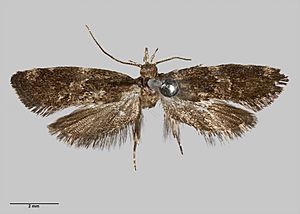Trachypepla nimbosa facts for kids
Quick facts for kids Trachypepla nimbosa |
|
|---|---|
 |
|
| Male holotype | |
| Scientific classification |
Trachypepla nimbosa is a small moth that belongs to the family Oecophoridae. It is a special kind of moth because it is endemic to New Zealand, meaning it is found nowhere else in the world. This moth is quite rare, and scientists don't have much information about it. Because of this, the Department of Conservation has listed it as "Data Deficient." This means they need more research to understand how many of these moths exist and if they are in danger. So far, scientists only know about this moth from one single specimen ever found.
Contents
Discovering the Trachypepla nimbosa
This moth was first described by a scientist named Alfred Philpott in 1930. He studied a male moth that was collected by Charles E. Clarke. This special moth was found in a place called Kauri Gully, near Birkenhead, on January 13, 1919.
Later, another scientist, George Hudson, wrote about and showed pictures of this moth in his 1939 book. This book was called A supplement to the butterflies and moths of New Zealand. The original moth specimen, which is very important for studying the species, is kept safe at the Auckland War Memorial Museum.
What the Trachypepla nimbosa Looks Like
When Alfred Philpott first described this moth, he noted that it was about 12 millimeters long. That's roughly half an inch! Its head and the part of its body where its wings attach (called the thorax) were a dark purplish-brown color. Its face had some yellowish-brown mixed in.
The moth's feelers (palpi) were bright yellowish-brown with some black. Its antennae, which are like its sense organs, were dark brown with yellowish-brown rings. The male moth had small hairs on its antennae. Its legs were grayish-brown with yellowish-brown rings on the feet (tarsi).
The front wings of the moth were long and dark brownish-black. They had some whitish-yellowish-brown mixed in. There were also small tufts of black scales on the wings, tipped with yellowish-brown. The back wings were a dark brownish-black.
Where the Trachypepla nimbosa Lives
As mentioned, the Trachypepla nimbosa moth is only found in New Zealand. So far, the only place it has ever been collected is Kauri Gully, which is where the first specimen was found. This makes it a very rare and special moth.
Life and Habits of the Trachypepla nimbosa
Scientists know very little about the daily life of this moth. We only know that the adult moths are active during the month of January. More research is needed to understand its full life cycle, what it eats, and how it behaves.
Protecting the Trachypepla nimbosa
The Trachypepla nimbosa moth has a "Data Deficient" conservation status. This means that scientists don't have enough information to know if it's truly endangered or not. It's like having a puzzle with too many missing pieces. To protect this unique New Zealand moth, more studies are needed to find out where else it might live and how many there are. This information will help conservationists make sure this species can survive and thrive.

